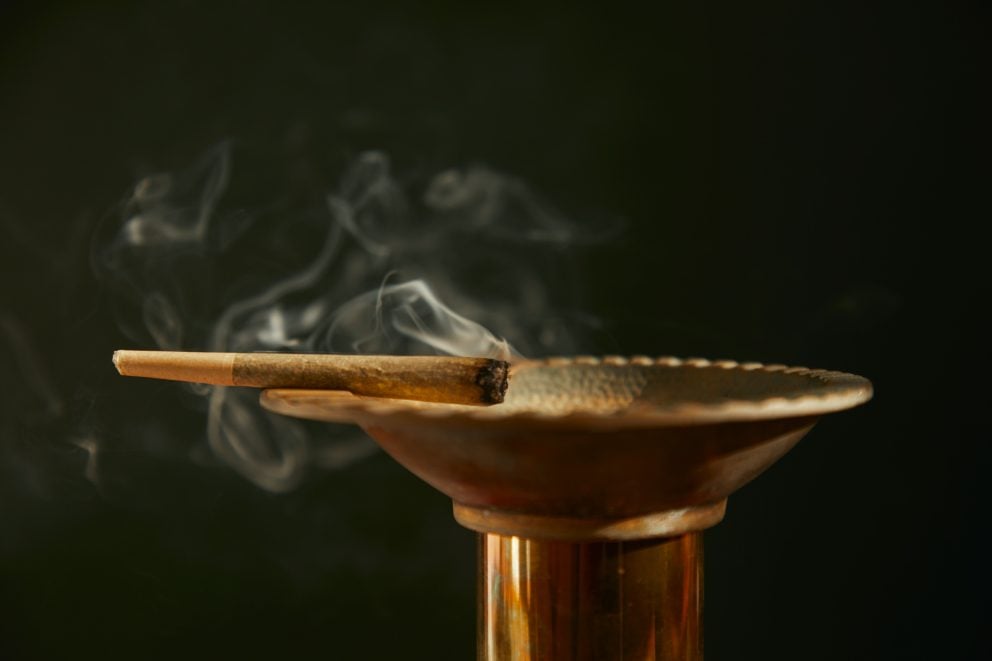
What is a T Break? Learn How to Lower THC Tolerance Fast with our Weed Tolerance Break Chart
While medical marijuana may not seem like traditional prescription drugs, cannabis is still a drug, and like substances ranging from prescription meds to caffeine to alcohol, your body can build up a tolerance. This resistance over time means you’ll need more to feel the same effects. The solution: a tolerance break.
What is a tolerance break? Generally, a tolerance break is when you simply take time away from a substance for your body to reset. This lowers your tolerance to ensure that you don’t become too numb to a drug’s effects or end up using too much.
Heavy cannabis users can find themselves using a large amount of cannabis or switching to high-THC products like dabs, moon rocks, or even pure THC crystalline to feel the effects others may get from a few puffs.
That may seem harmless but this can drain money, encourage dependency, and even have psychological effects. While weed is non-toxic and many of its negative effects can be reversible it’s important to take breaks.
How long should a weed tolerance break be? What can you do to curb withdrawal? This article will help you understand how to plan a tolerance break, how to support any symptoms during that time and other strategies for how to lower your tolerance for weed.
Apply for a Medical Marijuana Card Online Today
Join over 100,000 patients who have chosen Green Health Docs as their medical cannabis doctors. We have a 99% approval rate and offer a 100% money back guarantee!
What is Tolerance?
The human body was built to adapt and it will adjust to frequent exposure to a substance. There may come a time where you level up to two cups of coffee a day or you find a cocktail doesn’t quite give you the rush it did back in college.
The reason is our bodies will adjust on a molecular level to certain substances. Our body develops a tolerance. With cannabis, there’s also effects on our entire nervous system.
Regular cannabis consumption can actually reduce the number of CB1 receptors of our endocannabinoid system. That’s pretty serious considering the endocannabinoid system is a division of our nervous system that regulates body functions including hunger, energy metabolism, and inflammation.
Long term cannabis use can also negatively impact memory, and cognition. Studies have also shown that the hippocampus can shrink due to prolonged cannabis use. The hippocampus governs learning and memory.
Luckily, the neurological deficits caused by cannabis are reversible but they require that you abstain from cannabis for some time. Honestly, from a health perspective, a tolerance break from any substance can be amazing for the body and get you back down to one cup of coffee a day.
A few days away from caffeine, sugar, or salt can help you get a clearer picture of how these substances affect your body. They can also help you get clarity on how they make your body feel.
While on the surface a growing tolerance may seem like a petty annoyance, and, sure, there is an ever expanding list of medical benefits of cannabis still being discovered, your body can still use a break every once and a while.
How to Lower Weed Tolerance
The prospect of going cold turkey can seem intense for some longtime cannabis users. Before reviewing the tolerance break, here are a few alternatives and some ways how to speed up a tolerance break.
These are also great strategies to prepare leading up to a t break to temper any intense withdrawal and ensure your tolerance break goes more smoothly.

Photo by Dad Grass
Use it Less Often
If a tolerance break seems too extreme try paring down how often you’re consuming cannabis. If you use it more than once per day, bring it down to once a day. If you’re doing it everyday, try taking a day off in between each use.
The idea is rather than completely abstaining you can take your usage down slightly until taking a two day break doesn’t feel so extreme. This can also help lower your tolerance as your body readjusts.
Microdose
If you’re a big proponent of the multiple medicinal properties of cannabis and want to use it regularly the answer may lie in microdosing. Many use medicinal cannabis the way the average person uses it recreationally.
The high of THC doesn’t ensure the cannabinoids are at work. While patients with certain conditions may rely on high-doses of THC for pain management or to help during cancer treatments, for the average user a little can go a long way.
Microdosing allows you to have a small dose of cannabinoids regularly in your system but you’re not pursuing the high of THC which will elude you if your tolerance is too high.
Having a dose of about 2 to 5 milligrams of THC in an edible can offer a smaller dose of cannabinoids per day. Over time, this can help reduce the tolerance of heavy cannabis users.
Edibles, tinctures, or THC pills can offer a nice alternative to smoking and a simple way to microdose cannabis. Speaking of switching from smoking…
Try Consuming Cannabis Differently
There are multiple ways to consume cannabis and cannabinoids can affect the body in slightly different ways depending on how you consume it.
If you’re used to smoking weed, switching to edibles can change how your body processes cannabinoids and offer an alternative experience. With edibles, your body has more access points to engage with cannabinoids.
The body metabolizes THC differently when it’s consumed orally which can have slightly different effects on how you feel. Your body will convert THC into 11-hydroxy-THC which can interact with your body differently.
This can help with consuming less cannabis by taking advantage of the fact that your body will react differently. This can also give you a chance to take a break from your preferred method of consuming cannabis to help break the habit.
Chose Higher CBD Strains or Focus on Different Cannabinoids
Our understanding of cannabinoids is expanding, one alternative to THC is the countless other cannabinoids found in marijuana. THC, while offering a great high, is not the only psychoactive compound available. HHC, delta-8 and delta-10 can offer psychoactive experiences and offer you an alternative to wean yourself off too much THC.
Higher CBD strains are also a great alternative. CBD can counteract the high of THC but it’s also been found to have the potential to be neuroprotective which can help avoid some of the neurological issues with THC. Plus, CBD has its own host of health benefits.
If you want to lower your tolerance and not-quite-ready to cut out cannabis products altogether, switching strains, trying different cannabinoids, and avoiding THC can all help bring your tolerance down.
How to Lower THC Tolerance Fast
The fastest way to lower your tolerance is to completely abstain from cannabis. It’s easy in this day and age to want a quick fix. Luckily, a tolerance break doesn’t have to be super long.
The study that revealed a drop in CB1 receptors after prolonged cannabis use, has shown that your body can begin CB1 upregulation after only 2 days. Granted, the more time away from cannabis the lower your tolerance will go and the more you will counteract any negative neurological effects.
Taking regular breaks can help not just regulate your THC tolerance but also neurological effects of heavy THC use.
If you want to increase the effectiveness of your tolerance break try pairing it with exercise. Exercise will help you burn fat and boost your metabolism. THC is fat soluble and has been known to bond with fat.
Plus, people with more body fat can metabolize THC more slowly. Proper hydration can help with flushing your system. However, THC is fat soluble so hydration will not magically rid your body of THC.
Additionally, exercise and hydration can help mitigate some withdrawal symptoms.
Tips for Managing Withdrawal
While cannabis has countless health benefits, THC can be habit forming. Pure THC, whether as crystalline or dronabinol, has been known to have a potential for dependence
This dependence can be chemically, your body seeking to regulate its CD1 downregulation with more THC, or habit-forming because of other addiction triggers.
During a T-break or when stopping cannabis use, you can potentially face withdrawal symptoms or struggle with the conditions you’re using cannabis to manage. Here are a few tips for helping to manage THC withdrawal.
Exercise

Photo by Li Sun
Not only will exercise help with metabolizing THC, it will also help improve your mood. If you’re using THC for anxiety, depression, or other emotional or mood issues a little exercise can go a long way.
A new exercise regimen can help when shifting from habitual use of cannabis by giving you something new and a new source for endorphins and energy.
Find Alternatives
If you’re using medical marijuana for a specific health issue you can seek out another traditional prescription or homeopathic remedy. While it may not be as effective as THC, using an alternative for a few days can ensure that you get the most from your T break while also managing your illness or symptoms.
Maintain Your Sleep Hygiene
Many use cannabis to help with sleep. If you take a T-break you may find yourself facing struggles sleeping. So much of sleep issues has to do with sleep hygiene. If you only use your bed to sleep, avoid working, eating, and watching TV in bed you can help train yourself to more effectively wind down for sleep.
Also regulating your screen time before bed can also help you wind down. Getting enough sleep can also help manage irritability that may develop from withdrawal.
Find Help
People can become addicted to anything that alters how they feel. Emotional triggers and life issues can encourage dependency so talk therapy, support from friends and family, and support groups can help you handle any emotions or frustrations that come to the surface while taking your tolerance break.
Managing your withdrawal can help you not just reduce your tolerance but better manage your relationship with cannabis.
How Long Should a Tolerance Break be from Weed?
Now that you have a better understanding of what can happen on a tolerance break and how to prepare, there’s a choice for how long you want to take a break from using cannabis. This will vary depending on your usage, how you feel, and why you need to take a break.
If your goal is to completely reset your body to how it was before you began using cannabis you may need to take a few weeks. This will ensure all the THC has left your system and that your body has begun to completely regulate your endocannabinoid system.
There are no hard fast rules for tolerance breaks. How long a tolerance break from weed should be can vary from user to user. After all, cannabis affects you differently depending on your body type, body chemistry, and even your gender.
2 Day Tolerance Break
If you’re a habitual cannabis user and don’t use high THC products a 2 day tolerance break is more than enough. 2 days is also a great idea if you start to find yourself needing more THC to feel the same effects.
3 Day Tolerance Break
If you’re a regular THC user, you may want to give yourself at least three days. You’ll want to give yourself two full days for your body to process the changes and an additional day or more of padding to allow your body to readjust.
4 Week Tolerance Break
Heavy cannabis users can need as much as 4 weeks. The study found that it took 4 weeks for CB1 receptor density to reach the same levels as non-cannabis users. That also gives you enough time to ensure there’s no cannabis in your system.
How Often Should You Take a Tolerance Break?
A tolerance break may just seem like how you lower your tolerance for weed but t breaks are an important strategy for managing your relationship to cannabis. When to take a tolerance break depends on how you feel and getting to know your body.
When you find yourself needing cannabis to function or find that the usual amount isn’t enough to feel anything, that’s the ideal time to take a break. Rather than increase your intake try taking a t break.
This will help you not only lower your tolerance, but resist dependency and avoid any bad habits that can have you using too much cannabis. Not to mention ensure the proper response of your endocannabinoid system.

Photo by Pavel Danilyuk
How Do I Get My Appetite Back After Quitting Weed?
Heavy cannabis users can sometimes report losing their appetite after stopping cannabis use. It can almost be like a reverse attack of themunchies, with your body adjusting. When you stop using cannabis your endocannabinoid system is readjusting and that can have some side effects.
The key is to manage your lack of appetite and ensure that you’re eating properly. This can be a great opportunity to shift your diet or eliminate problematic substances like sugar or caffeine. As your body adjusts to your time without cannabis, your appetite will naturally return.
Here are some tips for managing appetite loss when quitting cannabis use.
Stay Hydrated
Hydration is key. Not only will water help with cellular function it can also help you better get in touch with your hunger.
Change How You Eat
If you really are struggling with eating, you can try smoothies, protein shakes, and soups to help keep your calories up. It’s also a great opportunity to try a new diet by building up the habits of eating more fresh vegetables.
You can also opt for more frequent smaller meals to ensure that you get enough calories. Snacks like fruit and nuts can be quick things you eat to keep your blood sugar up rather than gorging on large meals when your appetite is low.
Get To Know Your Body
After long term cannabis use, you can get used to the munchies. There are many different signals that let you know your body is hungry. It’s not always a rumbling tummy or rushing to snack.
You can start to pay attention to when you’re low energy, irritable, or tired to see when your body needs you to eat something.
Vitamins to Lower Weed Tolerance
Sadly, there’s a lot of misinformation about cannabis because there’s a lot of random data out there and only with growing legalization that more study is separating fact from fiction. Vitamins may seem like a magic way to lower a tolerance to weed.
There has been anecdotal data that says that Vitamin-C or omega-3 fatty acids can help lower your tolerance. These are incorrect and actually misunderstandings of similarities between these vitamins and cannabinoids.
Grapefruit juice and CBD both interact with enzymes that break down certain medications during digestion. This can seem to increase their potency because those drugs will take longer to break down.
Another confusion comes from research out of the University of Illinois that our body can create endocannabinoids from omega-3 fatty acids. These can interact with some of the CB2 endocannabinoid receptors that govern inflammation. A study in 2019 found that these endocannabinoids have no effect on cannabinoid tolerance.
That being said, taking a vitamin with omega-3s may help during a tolerance break by engaging with certain cell receptors.
Final Thoughts
Cannabis has countless benefits. Apply online for a medical marijuana card to try cannabis for your health needs.
Heavy cannabis use can cause certain neurological issues and dependency. While these are reversible, healthy use of cannabis can require abstaining and the occasional tolerance break. Too much of a good thing is never great for your health and anything, even cannabis, can require moderation.
 This article has been reviewed by Dr. Anand Dugar, an anesthesiologist, pain medicine physician and the founder of Green Health Docs. Graduating from medical school in 2004 and residency in 2008, Dr. Dugar has been a licensed physician for almost 20 years and has been leading the push for medical cannabis nationwide.
This article has been reviewed by Dr. Anand Dugar, an anesthesiologist, pain medicine physician and the founder of Green Health Docs. Graduating from medical school in 2004 and residency in 2008, Dr. Dugar has been a licensed physician for almost 20 years and has been leading the push for medical cannabis nationwide.
